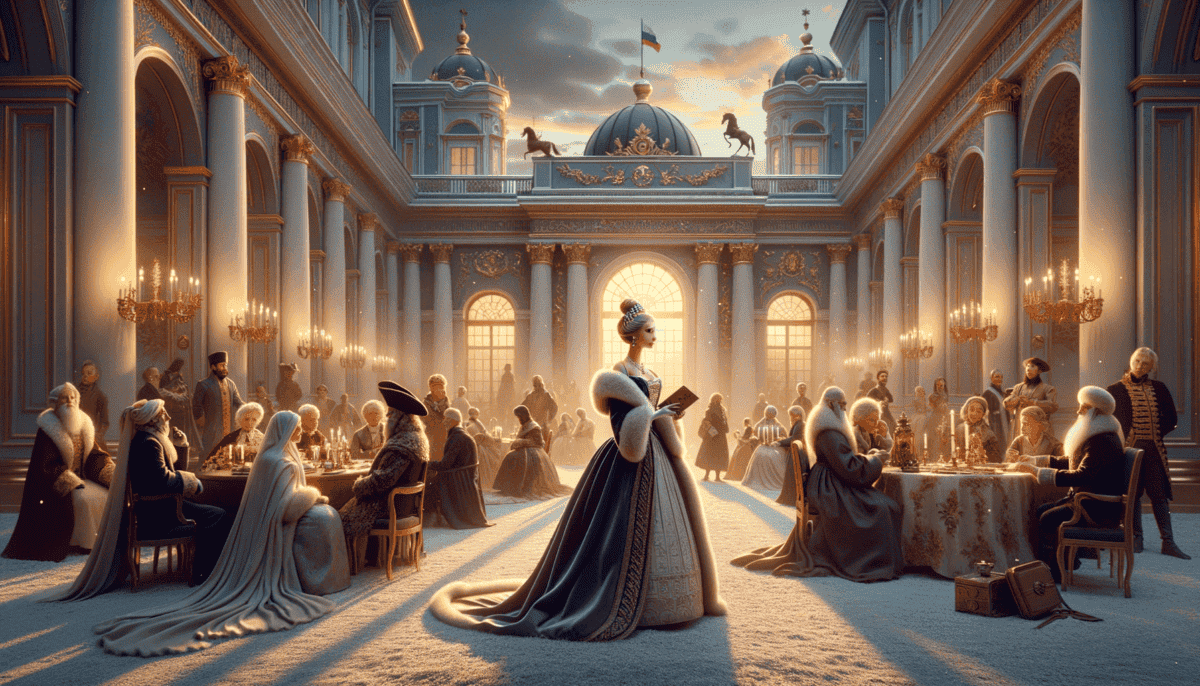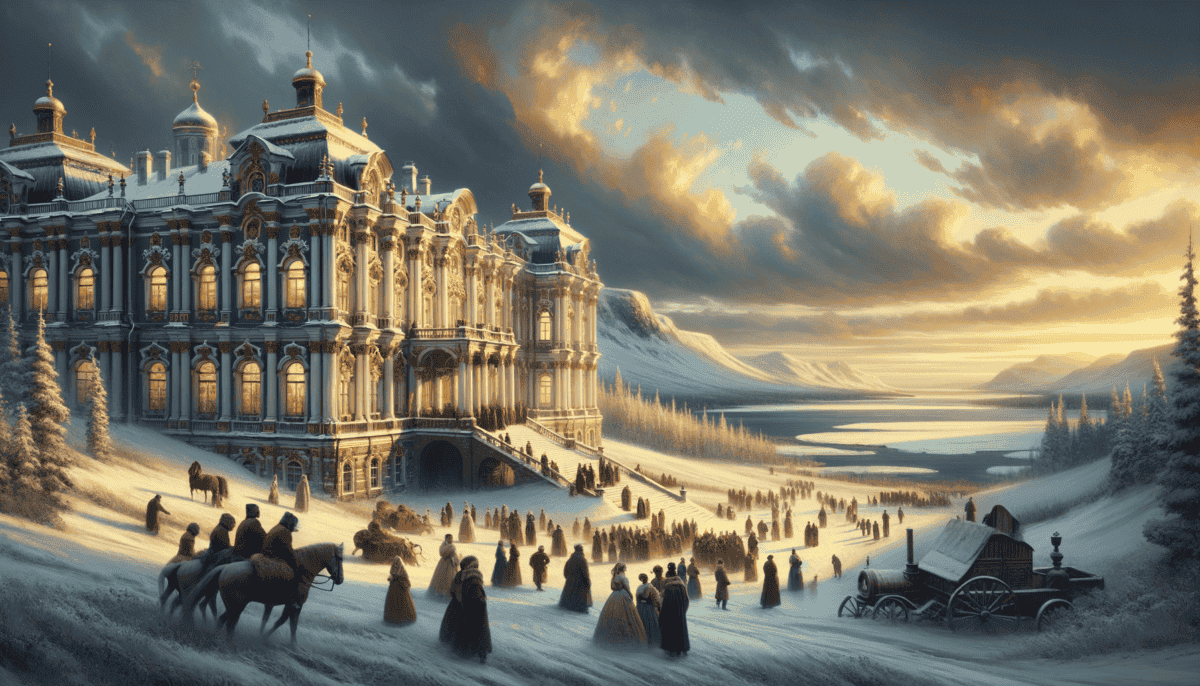A New Dynasty Begins
The snow fell softly over Moscow as young Michael Romanov walked through the grand halls of the Kremlin. It was 1613, and at just sixteen years old, he was about to become the new ruler of Russia.
"But Mother," Michael whispered, his voice trembling, "I don't know if I'm ready to be Tsar."
His mother squeezed his hand. "Russia needs you, my son. The people have chosen you."
The Boy Who Would Be Tsar
Russia had been through hard times. Bad leaders and fighting had left the country in trouble. The people wanted someone new to help make things better. They picked Michael because his family was good and kind.
"Why did they pick me?" Michael asked his advisor Boris.
Boris smiled warmly. "Because you come from a noble family that people trust. Your father was a wise church leader. The people believe you will bring peace."
Building a Better Russia
Michael worked hard to fix Russia's problems. He was like a doctor helping a sick patient get better. First, he made peace with other countries. Then he helped farmers grow more food.
"We must help all Russians," Michael told his advisors. "From the poorest farmer to the richest noble."
The young Tsar faced many challenges:
• Wars with neighboring countries
• Empty food stores
• Unhappy nobles who wanted power
• Rebuilding broken cities
But Michael was patient and smart. He listened to good advice and made careful choices. Slowly but surely, Russia began to heal.
A Growing Empire
As Michael grew older, he became wiser. Under his rule, Russia grew bigger. Brave explorers went east into Siberia, finding new lands with rich forests and fur-bearing animals.
"Look how far our people have gone!" Michael exclaimed, pointing to a map. "Russia stretches farther than ever before."
“A ruler must be like a father to his people,” Michael often said. “Kind but firm, caring for all equally.”
A Family Legacy
Michael married a kind woman named Eudoxia. They had many children who learned how to be good leaders. Michael taught them important lessons about taking care of Russia.
"Remember," he told his children, "Russia is like a big family. We must protect and care for everyone."
When Michael got older, he could look back proudly. He had turned Russia from a troubled land into a strong country. The people were happier, and there was more food for everyone.
Little did young Michael know when he first walked through the Kremlin that snowy day, but he had started something very special. The Romanov family would change Russia in ways nobody could imagine.
His son Alexei would become the next Tsar, ready to continue his father's good work. But that's another story, for another snowy day in Moscow…
The Great Transformer
The morning sun sparkled on the waters of the Neva River. A tall man with bright eyes stood watching workers build a new city. This was Peter, and he had big dreams for Russia. ️
A Different Kind of Tsar
“Look!” Peter shouted excitedly to his friends. “Here we will build the most beautiful city in all of Europe!”
Peter wasn’t like other tsars. He liked to work with his own hands and learn new things. He even traveled to other countries to learn their ways.
Building a New City
Peter wanted Russia to be more like countries in Europe. He decided to build a new city called St. Petersburg. It would be Russia’s window to the west.
“But Tsar Peter,” said an old advisor, “the ground is too wet. It’s all swamp!”
Peter smiled. “Then we will make it solid. Nothing is impossible!”
Thousands of workers came to help build the city:
• They dug canals
• Built beautiful palaces
• Made wide streets
• Created lovely parks
New Ways for a New Russia
Peter made many changes to help Russia grow stronger:
“We must learn from others to make ourselves better,” Peter often said to his people.
He told men to cut off their long beards and wear European clothes. Some people didn’t like these new rules, but Peter was determined.
Making Russia Stronger
“Our army needs better weapons,” Peter told his generals. “And our navy needs more ships!”
He built factories to make guns and started Russia’s first navy. Peter even learned how to build ships himself!
Fighting for Change
Not everyone liked Peter’s new ideas. Many old noble families thought he was changing too much, too fast.
“Why must we change our old ways?” they complained.
“Because the world is changing,” Peter would answer. “And Russia must change too!”
A Leader Who Never Stopped Learning
Peter worked hard every day. He would wake up early and visit factories, shipyards, and building sites. He wanted to see everything with his own eyes.
“A good leader must understand all parts of his country,” he told his son. “From the smallest workshop to the biggest palace.”
By the time Peter died, Russia was very different. It had:
– A strong army and navy
– Beautiful new cities
– Modern factories
– Better schools
– Closer ties with Europe
Peter had turned Russia into one of the strongest countries in Europe. His new city, St. Petersburg, became one of the most beautiful places in the world.
As ships sailed into the harbor of his new city, Peter would smile. His dream of a new Russia was coming true. But what would happen next? Who would continue his work of making Russia modern and strong?
The Empress’s Golden Touch
A young princess named Sophie sat reading by candlelight. She was learning Russian, even though her fingers were cold and stiff. One day, she would become Catherine the Great – Russia’s most amazing empress!
A Smart Girl Becomes Queen
“I will be the best ruler Russia has ever seen,” Sophie whispered to herself. She changed her name to Catherine when she came to Russia.
Catherine loved to learn. She read lots of books and talked to smart people about new ideas. “Knowledge is power,” she would say with a smile.
Making Russia Shine
When Catherine became empress, she had big plans:
“Let’s make Russia the most beautiful and clever country in the world!” she declared to her helpers.
She built beautiful buildings and started many schools. Artists and writers came from all over Europe to live in Russia.
Growing the Empire
“Russia needs more room to grow,” Catherine told her generals. She was very good at making Russia bigger.
Under Catherine’s rule, Russia got:
• New lands in the south
• Warm seas for ships
• Rich farming areas
• More people and cities
Friends in High Places
Catherine wrote letters to famous people all over Europe. She was pen pals with writers and thinkers!
“Dear Voltaire,” she would write, “tell me more about your ideas for making people’s lives better.”
She used these ideas to help Russia grow and change.
Not All Gold Glitters
But life wasn’t perfect for everyone. Poor farmers called serfs still had very hard lives.
“Please help us, Empress!” they would ask.
Catherine tried to make some things better, but changing everything was hard. Some people even got angry and started fights.
A Smart Leader’s Legacy
Catherine ruled Russia for 34 years. During this time, she:
– Built beautiful palaces
– Started new schools
– Made Russia bigger
– Helped artists and writers
– Made Russia famous in Europe
At night, Catherine would still read by candlelight, just like when she was young. But now she was reading letters from kings and queens, planning new cities, and dreaming up ways to make Russia even better.
The old palace guards would see her light burning late into the night. “Our empress never stops working,” they would say proudly.
Russia grew rich and powerful during Catherine’s time. People called it the Golden Age. But dark clouds were gathering. The poor people of Russia were getting tired of their hard lives. What would happen when they couldn’t take it anymore?
Lives in Shadows and Chains
Ivan wiped sweat from his brow as he worked in the wheat fields. The hot sun beat down on his back. He was a serf – which meant he belonged to the rich landowner like a tool or a horse.
A Day in Ivan’s Life
Every morning before the sun came up, Ivan’s wife Maria whispered, “Time to work, my love.” Their small wooden hut barely kept out the cold.
“Papa, why do we work so hard but still stay poor?” asked Ivan’s little daughter Ana.
“That’s just how things are, little one,” Ivan said softly. “But maybe one day things will change.”
The Weight of Chains
Serfs had to follow strict rules:
• Work the lord’s land first
• Give most of their food to the lord
• Ask permission to get married
• Stay in their village forever
“Remember when Pavel tried to run away?” Maria whispered one night. “The soldiers brought him back in chains.”
Dreams of Freedom
Some nice people in the cities started talking about helping the serfs. They wrote books and gave speeches.
“Have you heard?” whispered the old farmer Mikhail. “They say the Tsar might set us free!”
Whispers of Change
In secret meetings at night, serfs shared stories of hope. Some learned to read, passing around forbidden books about freedom.
“We are humans too,” Ivan told his friends. “We deserve better than this.”
But the lords didn’t want things to change. They liked having free workers.
Breaking Chains
Finally, in 1861, something big happened. Tsar Alexander II made a new law setting serfs free!
“We’re free!” people shouted in the streets. “No more belonging to the lords!”
But freedom came with problems. Serfs had to pay lots of money to get their own land. Many stayed poor and hungry.
Seeds of Anger
Ivan looked at his calloused hands. “Free on paper,” he said, “but still chained by poverty.”
The anger of poor people grew stronger. Some started talking about bigger changes – about making Russia completely different.
In the cities, workers began meeting in secret. They shared new ideas about everyone being equal. The seeds of something bigger were starting to grow.
As night fell over Russia’s vast fields, millions of tired workers like Ivan went home to their families. They were free now, but their struggles weren’t over. A storm was brewing in the Russian Empire – one that would change everything forever.
Storm Clouds Gathering
Dark clouds rolled over St. Petersburg as factory smoke filled the air. Workers trudged through muddy streets, their faces tired and dirty.
The Breaking Point
“Another cut in our pay!” growled Dmitri, wiping soot from his face. “How are we supposed to feed our families?”
In the dim light of their tiny apartment, Dmitri’s wife Anna counted their few coins. “The bread costs more every day,” she whispered.
A War Nobody Wanted
News spread through the streets: Russia was fighting Japan! ️
“Why are we sending our sons to die?” people asked. “We can’t even afford to eat!”
The war went badly. Russian ships sank. Soldiers died. People got angrier.
Secret Meetings
At night, workers met in basements. They shared new ideas about changing Russia:
• Everyone should have enough food
• Children should go to school, not work
• Workers should have better lives
• People should choose their leaders
“We’re tired of being hungry!” Dmitri told the crowd. “We’re tired of being poor!”
A Peaceful March
One cold Sunday in 1905, thousands of workers walked to the Tsar’s palace. They carried pictures of him and wanted to give him a letter about their problems.
“They shot at us like we were animals!” Anna cried that night. “The Tsar doesn’t care about us at all!”
The Fire Spreads
After that terrible day, anger spread like wildfire. Workers stopped working. Sailors on battleships refused to fight. Farmers took over rich people’s land.
“Look!” shouted young Pavel, pointing at the newspaper. “Even soldiers are joining our side!”
Small Changes, Big Dreams
The Tsar made some small changes to calm people down. He created a parliament called the Duma where people could talk about problems.
But it wasn’t enough. The Tsar still had all the real power. Poor people were still hungry. Workers still worked too hard for too little.
“These little changes are just crumbs,” Dmitri told his friends. “We need real change!”
As winter came, people huddled in their cold homes. They whispered about revolution – about making a whole new Russia where everyone would have enough.
The storm clouds were getting darker. Something big was coming to the Russian Empire, something that would shake the whole world.
The Last Days of Empire
The winter of 1917 wrapped St. Petersburg in ice and darkness. People were cold, hungry, and angry.
A World at War
World War I had been going on for three years. Russian soldiers didn’t have enough food or warm clothes. Many got sick or died.
“My brother died at the front,” little Masha told her mother. “Why won’t the Tsar stop the fighting?”
The Bread Riots
One cold February morning, women lined up for bread. The stores were empty.
“We can’t feed our children!” they shouted. “We want bread! We want peace!”
More people joined them. Soon, thousands filled the streets. Even the police joined their side!
The Big Change
Things people wanted to fix in Russia:
• Stop the war
• Get more food
• Give workers better jobs
• Let people be free
• Make life fair for everyone
The Tsar tried to stop the protests, but it was too late. His own advisors told him to give up his crown.
The End of the Romanovs
“I give up being Tsar,” Nicholas II wrote on a piece of paper. “For Russia.”
A New Russia Begins
People danced in the streets. Red flags waved everywhere. A new group called the Soviets took over.
“We’re making a new country,” Dmitri told his children. “One where everyone has enough to eat and a warm place to sleep.”
Looking Back, Looking Forward
The mighty Russian Empire had changed forever. From the first Romanov tsar to the last, it had been full of big dreams and hard times.
The story of Russia didn’t end there. A new chapter was starting – different from anything that came before.
Old Grandfather Ivan smiled as he watched children playing in the street. “Remember this day,” he told them. “You’re seeing history happen!”
As the sun set on imperial Russia, it rose on a new tomorrow. The world would never be the same. ✨






